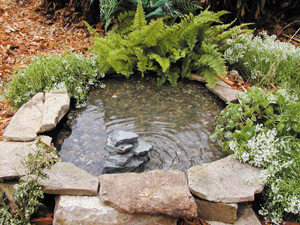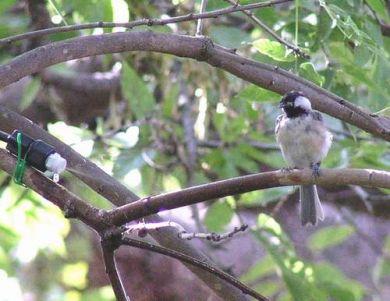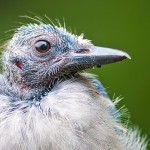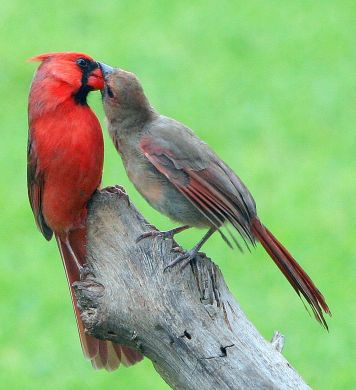Blog - General
Dave’s July Bird Chatter, 2012
The mild winter and even milder spring seems to have led to a rather hot summer. The birds have made it to their nesting grounds and are currently raising families. Hard to imagine in a short 4 to 6 weeks the songbirds will begin drifting south on a slow migration. Wrens seem to be plentiful. I hear them most everywhere I go. Purple Martins are fledging their young, and Bluebirds appear to be having a good season with folks enjoying them for the first time after installing nest boxes. Many customers have Orioles, Rose-breasted Grosbeaks, and Indigo Bunting gracing their yards. The length of time they visit the bird feeders depends on where you live and how vigilant you are to keep their food available. Summer bird feeding has been most enjoyable with a good variety of birds visiting well stocked feeders.
As normally happens when the weather turns hot and humid the amount of food and frequencies of birds visiting your feeders may subside a bit. Hot weather saps the appetite of birds reducing the amount of food they need. This type of weather also makes many animals including humans lethargic. On these hot days the birds will feed early in the day and again late in the afternoon to early evening avoiding the midday heat. You may witness some birds on the ground in shady areas with wings spread and beaks wide open. This is one way, other than bathing, to cool down a little. Birds lack sweat glands and will pant much like a dog to relieve heat build-up.

We hope that this might be the year you add a water source to your backyard bird feeding program if you haven’t already. A moving source of water is especially attractive to birds. I know from years of experience how much more of a draw moving water is to birds compared to a bird bath. Many tests have indicated moving water attracts as many as five times the number of birds as does standing water. It also attracts birds to your yards such as warblers that are not particularly interested in the bird feeders you maintain. This attraction is due to the sound moving water makes which birds can hear at a good distance. When they come to investigate it the moving water is such an enticement they cannot turn down the opportunity for a quick dip and a drink. Just remember that an important variable for attracting birds to water, whether in an avian pond or bird bath, is providing shallow areas for smaller birds. Wild Bird Habitat can give some advice on a very simple garden pond with a waterfall rock. Just ask Dave. These ponds can be operated throughout the winter months with a simple bird bath heater installed. They are actually easier to maintain than many bird baths.

A mister in a shrub can be extremely entertaining as birds will take a leaf bath against the moistened leaves. If you turn it on approximately at the same time every day and run it for a period birds will recognize that is the time to enjoy a good bath to cool down. Misters take very little water and what is used will help the plant through the hot days as well. A water timer can be added.
This is vacation time for many families and individuals. Trips are being planned for traveling to other parts of the country and geological locations. You are sure to see a change in the variety of bird species you will encounter, even if you are not out actively bird watching. This includes a simple trip across Nebraska where you’ll pass through a variety of different ecological regions. And once you enter into the more than 19,000 square miles of Sandhills on into Western Nebraska you will see a variety of western bird species that do not occur in the eastern part of the state.
This, along with the major migratory flyways that pass through the state, make Nebraska one of the top bird watching regions on the northern continent. So at the Wild Bird Habitat Stores we encourage everyone to have a field guide and get familiar with using it. Make certain the guide lists the birds for the regions you plan to travel through. And if you plan on leaving the country to travel to far off places, we can get a bird identification guide specific to any state or country. Honing your skills for using a field guide now will make it easier to identify birds passing through your yard during fall migration which is not too far off.

During the month of July, and into August, you might be noticing some “bald” birds. This seems most common in Cardinals, Blue Jays, and blackbirds. This baldness is caused by feather mites and does not harm the birds but may cause them some embarrassment. These mites clip off the feathers on the head at the skin line which do not grow back until the fall molt. Again there is no cause for alarm as it is harmless to the birds and does not affect humans.
July is the primary nesting period for the American Goldfinches and Cedar Waxwings. This period coincides with the ripening of certain plants that provides fibrous materials for constructing nests as well as seeds and berries for each of these species. Goldfinch feed their nestlings strictly seed after hatching and mid-summer provides a hearty bounty of these food products. Waxwings not only feed their young insects that have become plentiful by now, many of which are considered pests, but the berries and fruits on a variety of shrubs and trees have ripened offering additional food sources.
One of the most enjoyable aspects of summer bird feeding is watching the adult birds bringing their young to the backyard bird feeders. What a delight to sit outside on the deck or patio and watch these dedicated parents take care of their offspring while these fledglings go about exploring this mysterious world. Just to watch these youngsters explore water for the first time is a treat. But they learn quickly. Life in the wild depends on the ability to learn fast.

Over the past few weeks the onslaught of young birds my wife and I have enjoyed watching in the backyard is typical if you maintain the bird feeders, have some natural habitat, and a good source of water. We have seen Chickadees feeding Nutra-Saff Safflower seed to their newly fledged babies. The adult male Cardinal busily feeding his two youngsters while the female is probably starting a second brood. The male Downey Woodpecker is working hard to keep up retrieving suet from the suet feeder for his fledglings and occasionally treating them to bits of shelled peanuts. And one of my favorites is the Red-bellied Woodpecker who takes advantage of exploiting every type of food we provide for the birds. From suet to peanuts in the shell, their young have a very diverse diet. The best all-around woodpecker feeder we have other than the suet feeders are the caged feeders which all woodpeckers can freely feed from, but grackles and squirrels cannot.
We’ve watched baby Blue Jays, Robins, House Finch, and many others visit our yard for food, water, and shelter. They entertain and amaze us. Birds continue to be one of the greatest resources that connect us with nature on a daily basis. We want to thank you for supporting the Wild Bird Habitat Stores for the past 19 years and we hope to continue to serve your enjoyment of the birds. Good birding to you all.
Dave Titterington & the Staff at the Wild Bird Habitat Store
